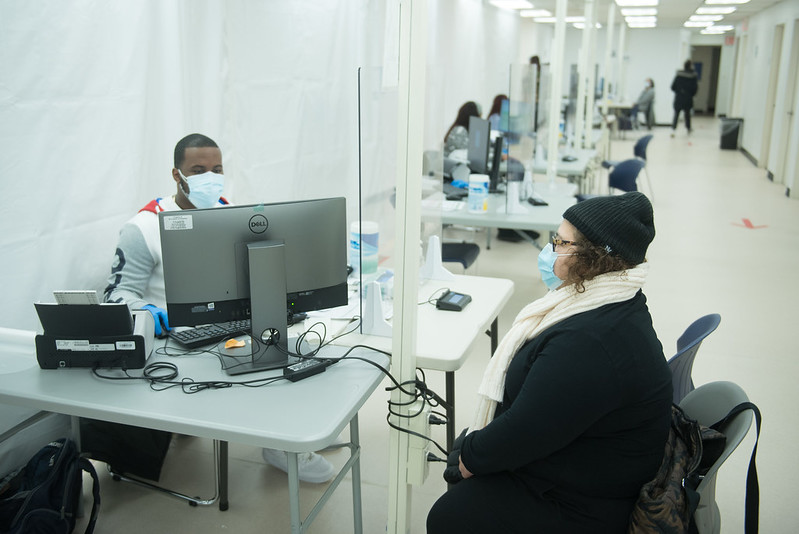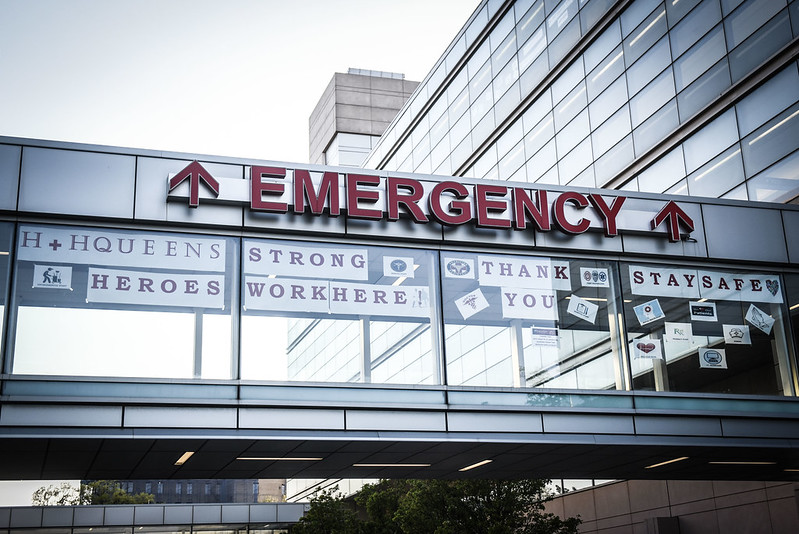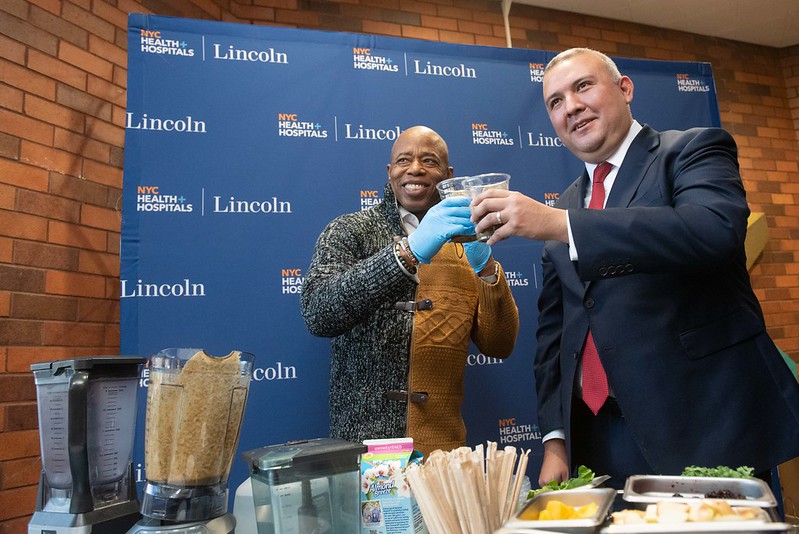New York Leaders Must Not Let Health Insurance Companies Coopt Patient Protection Law

Seeking health care (photo: Michael Appleton/Mayoral Photography Office)
In 2014, New York became the first state to enact a law addressing surprise medical bills. Congress followed suit in 2020 with the No Surprises Act.
Now, as Governor Hochul works to put New York law in line with federal standards, health insurance companies are attempting to co-opt the law with a one-line provision they lobbied for in Hochul’s budget proposal that would put health-care providers at a disadvantage in billing disputes. If approved by the Legislature, this biased proposal will threaten access to life saving emergency care while boosting health insurers’ already record-breaking profits.
Surprise medical bills, which have long plagued the U.S. health-care system, occur when a patient receives care from an out-of-network physician, usually in an emergency room or in an outpatient setting where the patient was unaware that the attending physician was out-of-network, and the insurer refuses to pay.
For years, surprise bills placed a heavy burden on American families, leaving them to cover the entire cost of emergency care as insurers collected increasing premiums. By implementing a dispute resolution process for out-of-network care, New York’s landmark surprise bill law rightfully ensured that out-of-network billing is resolved between insurers and providers, relieving patients from having to pay for life-saving emergency care out of pocket.
New York’s surprise bill law became the model for the federal No Surprises Act – and for good reason. In the first three years following its implementation, the New York State Department of Financial Services found that the law saved consumers over $400,000,000. The process is both fair and accessible, allowing each side to present its best offer to an independent arbitrator who in turn selects the most reasonable proposal. In doing so, the model encourages disputing parties to submit fair claims to the arbitration process while ensuring that neither party has extra influence over the decision.
But the governor’s Executive Budget contains a provision to mandate that dispute resolution arbitrators consider the average payment an insurance company would reimburse in-network providers, also known as the qualifying payment amount, or QPA. Expressly mandating inclusion of median reimbursement amounts – which are already permitted for consideration in the existing dispute resolution system – in the arbitration process would provide a significant advantage for the insurer.
If enacted, the inclusion of this amount would lead more physicians to lose out in the dispute process. How so? The insurance company rate is by no means a verifiable market rate charged by physicians day in and day out. Instead, it is reflective of insurance companies’ market power. Using these same metrics, an American Hospital Association survey found that Medicare reimbursement was $53.9 billion lower than actual costs. For patients, this formulation would be disastrous, as health-care professionals would be less likely to provide emergency care and other services.
Simply put, these payment cuts would lead many of the affected practices to close their doors. That leaves patients without the care they need. Moreover, this budget language is not required by federal law; in fact, Texas’ Eastern District Court rejected similar provisions shoehorned into regulatory code last month.
Despite this, it is no surprise that insurance companies – ever eager to squeeze more profit out of patients and providers – have identified New York as the next frontier for tipping the dispute resolution scale in their favor. The Legislature has rejected all surprise billing language, both the good and bad, from their one-house proposals, but who knows what will end up in the final budget deal due by April 1.
Health insurance companies are massively profitable and have exploded in value in the last decade. Take, for example, UnitedHealthcare, whose stock was trading at around $50 per share in March of 2012; ten years later, UnitedHealthcare’s stock trades at around $500 per share. Despite record growth and profits, insurers continue to raise premiums without expanding coverage, increasing the already heavy burden of health-care costs for American families. The new provision in the Executive Budget is a transparent power grab by the industry that would accomplish nothing for patients and providers while feeding insurers’ ever-growing profit margins.
The blockbuster success of insurers in recent years stands in stark contrast to the situation facing many independent medical practices in New York and across the country. When COVID-19 first swept across the country in 2020, and as the Delta and Omicron variants surged last year, health-care providers had to halt elective procedures, losing a key stream of income, while many patients opted to delay or even forgo care entirely. When the federal government allocated aid for hospitals in response to the pandemic, the vast majority of funds went to large hospital systems, with some like Northwell Health receiving upwards of $1 billion. Small, independent providers, on the other hand, have been largely left out to dry by Uncle Sam.
If the new provision being pushed by insurance companies is passed, the impact on independent providers and the communities they serve will be devastating. A dispute resolution process tilted in favor of insurers will drastically reduce revenues for providers – while large hospital systems may be able to absorb such a blow, many small and independent practices could be forced to close their doors, costing important health-care jobs and reducing the number of options available for patients.
Health insurance companies, it seems, will never be satisfied with record-breaking profits. Always seeking to extract more profit from hard-working New Yorkers, insurers have spared no effort in trying to subvert the state’s surprise bill statute, impact on providers and patients be damned. The question remains: will our leaders stand up to the insurers, or will they be allowed to subvert the law for their own profit?
***
Christopher Sheeron is president at Action for Health, a nonprofit advocacy organization dedicated to ensuring fair outcomes for critical healthcare issues.
***
Have an op-ed idea or submission for Gotham Gazette? Email This email address is being protected from spambots. You need JavaScript enabled to view it.
Time for New York to Act: Everyone Deserves Quality Health Care, No Matter Their Immigration Status

Avoiding the emergency room (photo: Michael Appleton/Mayoral Photography Office)
Mateo first came to the United States to be a caregiver for his terminally ill brother, who had cancer. Shortly after his brother passed away, Mateo went to a regular doctor’s check-up. He had not been feeling well lately. After further tests, doctors determined that his kidneys were failing. Since then, Mateo has been reliant on hemodialysis, a treatment intended to help a patient with kidney failure survive while they wait for a transplant.
But Mateo is not able to get on a waitlist for the kidney transplant that would save his life. Why? He is one of the estimated 400,000 undocumented and uninsured immigrants in New York state. Despite the contributions immigrants like Mateo make every day to our community as well as to the economy, New York leaves them without support when they need it most.
At the onset of the pandemic, Mateo contracted COVID-19. He had to be hooked up to a ventilator and nearly died. Unfortunately, Mateo’s experience is not uncommon for immigrants in New York.
Our state has spent the last two years fighting against the spread of COVID-19, and immigrants have played a huge role. They pay billions in taxes every year and serve as essential workers on the front lines of the fight against COVID-19. And yet they are systemically left without access to health care. The pandemic has shown how essential that care can be: it is estimated that over 2,000 undocumented New Yorkers died from COVID-19 due to a lack of health coverage.
This is the daily reality for Mateo, who uses Emergency Medicaid, the only form of insurance he is eligible to receive. Emergency Medicaid only covers the treatment of severe “acute symptoms” that threaten an individual’s health. This means that Mateo’s dialysis is covered, but the treatment of other conditions that intersect with kidney failure (such as heart problems and loss of vision) are not – and neither is a kidney transplant. While undocumented immigrants can be organ donors, they are excluded from receiving organs themselves. New York benefits greatly from the contributions of immigrants like Mateo but does not give back to them to anywhere near the same degree.
Preventive care has the potential to save both money and lives; the Centers for Disease Control and Prevention estimate that about 90% of annual health expenses go to treatment of chronic physical and mental health conditions, many of which are preventable and treatable when addressed early. However, preventive care is not included in Emergency Medicaid coverage, which many immigrants rely on. Had Mateo been able to visit the ophthalmologist when his doctor recommended it, his eyes may not have suddenly started bleeding, requiring surgery. Due to the cost, he has also had to put off visiting a cardiologist despite the urging of his doctor.
Providing only emergency care is simply not enough. Mateo’s trips to dialysis three times per week are only intended to help him survive while he waits for a transplant. Once one’s kidneys have failed, they cannot be recovered; a transplant is the only permanent solution.
Mateo’s experiences demonstrate how a lack of insurance prevents immigrants from accessing the care they need. Many uninsured individuals may delay going to the doctor until it is too late due to an inability to pay. Health problems like heart disease, diabetes, or other chronic illnesses are known to make one more likely to get severely ill with COVID-19. While these conditions may be treatable or preventable, uninsured immigrants are left as though those treatments don’t exist, instead forced to face the serious and often fatal consequences of a condition that has been treatable for decades.
Luckily for Mateo and other immigrants like him, there is a solution. A proposed state law, (A880A/S1572A), would create a state-funded Essential Plan for all New Yorkers earning up to 200% of the federal poverty level, regardless of immigration status. If this law were passed, Mateo and thousands of others would be able to access the life-saving medical coverage they need and deserve. Other states are expanding access to health care in similar ways, including California, Minnesota, and Illinois. New York cannot be left behind on this. All New Yorkers deserve access to healthcare, no matter what their immigration status.
Immigrants are at the heart of New York’s communities: they are friends, parents, children, colleagues and partners. They pay taxes, work as essential workers and donate their organs. Still, many are left out of necessary health coverage. They contribute just as much as their neighbors who have citizenship, yet they receive far fewer benefits. This blatant discrimination is unacceptable. New York must pass coverage for all to ensure that every New Yorker, no matter their immigration status, has access to quality health care.
***
Emily Hodgkins is a Post-Graduate Legal Fellow in New York Lawyers for the Public Interest’s Health Justice Program.
***
Have an op-ed idea or submission for Gotham Gazette? Email This email address is being protected from spambots. You need JavaScript enabled to view it.
Turn to Communities to Turn Around New York’s Unprecedented Health Disaster

Mayor Adams promotes good health (photo: Michael Appleton/Mayoral Photography Office)
New York City and State face unprecedented mass illness--from chronic disease that has been allowed to fester for decades, ongoing endemic COVID-19, and uncountable already existing cases of Long Covid--plus rising overdose rates and emergency illness from drug use, and more. With all this, mass trauma has overtaken whole communities. There will never be sufficient professional personnel, from clinicians to police officers, to contend with this unprecedented nightmare.
What to do?
Let’s go back 30 years to when the epidemic of HIV/AIDS collided with the staggering crack epidemic, creating similar conditions. What happened then was a formidable lesson. As systems simply broke down, communities themselves actually stepped in to slowly but surely rebuild themselves.
As the worst-hit AIDS communities began to undertake education and prevention for themselves, the important phenomenon of peer education--reaching high-risk people through outreach by others from their community---for the first time gained widespread use in New York. The Gay Men’s Health Crisis (GMHC), started to fight AIDS, massively fielded peer educators. “Harm reduction” services, largely conducted by recovering drug users, for the first time widely reached addicts. With these efforts, new HIV infections plunged even before effective treatment for HIV/AIDS became available.
In sum, peer educators, often from the most vulnerable and poorest communities, some lacking even a high school degree, made themselves into a never-before-seen force for progress in community health.
One difference today is that the situation is far, far worse. With their billions in federal recovery money, the state and city must now widely support peer initiatives that rebuild community health.
Peer support can be attached to clinical services as seen at Fountain House, the outstanding mental health program that New York City’s new health commissioner, Dr. Ashwin Vasan, led for years. But peer services fielded directly by community groups also achieve remarkable progress.
One area for immediate attention is diabetes and other major chronic diseases, which both the city and state simply ignored during the de Blasio and Cuomo years. Our public health departments are playing with fire, and abandoning their core responsibility by even now continuing to let chronic disease climb and refusing to support proven peer-delivered self-care education in the neighborhoods most in need.
The impact of widely available self-care education on reducing the human toll and public cost of diabetes alone would be staggering.
One million New Yorkers have diabetes, which is also a “gateway” disease that worsens stroke and heart disease and causes some 90% of lower-limb amputations and 45% of dialysis cases.
The Diabetes Self-Management Program (DSMP), a six-session course that is the best-known diabetes self-care course, reduces blood sugar--which immediately reduces vulnerability to the worst covid outcomes--as well as overall complications and costs. It also lowers the high rates of co-morbid depression seen in diabetes, improving the city’s frighteningly deteriorated mental health. And, evaluation repeatedly shows that it slashes emergency room visits by 40% or more—an extraordinary benefit in relieving the overwhelming pressure now on front-line clinical staff.
By using peers, this critical self-care education can be launched quite quickly. When my South Bronx organization had special federal funding (now terminated), we instituted a four-week program to train low-income people with diabetes or pre-diabetes to deliver the DSMP. These peer educators, being from the community, fanned out to dozens of community sites--churches, homeless shelters, mental health programs, public housing where they already had connections--and enrolled almost 2,000 Medicaid recipients with Type 2 diabetes in the DSMP.
This was evidently the largest community mobilization for diabetes self-care education ever to occur in the United States, and there are capable community groups across the city who could learn to get the DSMP up and running.
Through new relationships it formed with dozens of community groups during covid and the Adams administration’s new office of Faith-Based and Community Partnerships, among other entities, the city could create an army of peer educators never seen before, with the capacity to deliver effective chronic disease self-care education, in multiple languages, to almost every corner of the New York, measurably renewing health.
Not incidentally, when my organization took the DSMP to homeless shelters, the city Department of Health’s own evaluation showed a 45% drop in participants’ emergency room visits.
Yet, neither the New York City nor New York State department of health has ever spent a penny to support the DSMP, or other proven chronic disease education delivered by communities, themselves.
We can much hope that will change with the new Adams and Hochul administrations; but change must be soon. The longer people remain massively sick without intervention to improve their self-care, the sicker and sicker they get, and the more vulnerable they remain, even two years later, to the worst that COVID-19 does.
***
Chris Norwood is Executive Director of Health People, the community preventive health institute. On Twitter @HealthPeopleOrg.
***
Have an op-ed idea or submission for Gotham Gazette? Email This email address is being protected from spambots. You need JavaScript enabled to view it.




